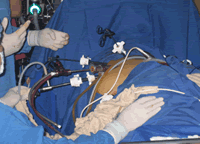

Laparoscopy was first performed in 1901 by Kellig to view the abdomen of a dog. A century later, it has gained popularity and widespread use in multiple specialties. Dr Clayman of UCLA-Irvine was the first urologist to perform laparoscopic procedures during the early 90's. Presently, laparoscopy is slowly being included in the urologist's armamentarium.
Laparoscopic urology is a technique in performing major urologic surgery through several tiny (0.5cm to 1.0cm) incisions, instead of the long incisions, that have been traditionally used. Laparoscopy uses a camera that is inserted inside the abdomen through one of the small incisions so that organs can be visualized using a telescope, and manipulated with long thin instruments likewise inserted into the abdomen through small incisions.
Although in essence this technique employs keyhole surgery, the view obtained is much better than looking through a keyhole. Modern camera equipment produces a wide, bright, clear, magnified view of the operation.
Additionally, though using only small incisions, laparoscopic surgery requires general anesthesia like open surgery.
Many documented advantages have been demonstrated compared with the traditional open surgery.
* Because of the small wound size, this technique produces much less pain thus requiring less pain medications
* Less blood loss
* Shorter hospital stay
* Favorable cosmetic result with smaller scars
* Recovery time greatly reduced resulting to earlier return to work and normal daily activities
Whatever is the goal of open surgery can also be achieved using laparoscopic surgery
The are several urologic procedures being done laparoscopically namely:
* Laparoscopic lymph node dissection
* Laparoscopic adrenalectomy
* Laparoscopic cyst unroofing/decortication
* Laparoscopic nephrectomy
* Laparoscopic partial nephrectomy
* Laparoscopic nephroureterectomy
* Laparoscopic radical nephrectomy
* Laparoscopic donor nephrectomy
* Laparoscopic pyeloplasty
* Laparoscopic radical prostatectomy
The estimated complication rate of laparoscopic urologic surgery is less than 5%. The most common risks include bleeding, infection, and injury to adjacent organs such as liver, bowel, spleen, pancreas and vascular structures. These complications do also happen with open surgery.
Conversion to open surgery after initial attempts of laparoscopy are sometimes necessary to safely complete the procedure but is never considered a failure of surgery.
Although laparoscopic surgery is easier on the patient than open surgery, it is technically more difficult to perform than that of equivalent traditional open surgery that it sometimes takes longer time to perform.
In the Philippines, the National Kidney and Transplant Institute is the pioneer institution where this procedure is commonly performed and has the largest experience with this technique.
Laparoscopic milestones in the National Kidney and Transplant Institute
2001 first laparoscopic pelvic lymph node dissection.
first laparoscopic hand-assisted nephrectomy
2002 first laparoscopic adrenalectomy
first full laparoscopic nephrectomy
2003 first full laparoscopic radical nephrectomy
2004 first laparoscopic donor nephrectomy
first laparoscopic radical prostatectomy
2005 first laparoscopic orchiectomy for undescended abdominal testis
2007 first laparoscopic partial nephrectomy
Laparoscopic procedures for urology is gaining popularity in our country. IT IS NOTEWORTHY TO KNOW THAT THE EXPERTISE IN LAPAROSCOPIC UROLOGY IS ALREADY AVAILABLE IN DAVAO CITY AND SOME INSTITUTIONS HERE IN THE CITY ALREADY HAVE LAPAROSCOPIC INSTRUMENTS.
LAPAROSCOPIC DONOR NEPHRECTOMY (NKTI)

No comments:
Post a Comment